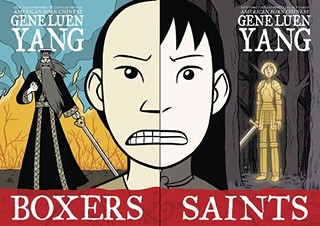One-Two Punch
Gene Luen Yang's 'Boxers' and 'Saints' duo takes on the Boxer Rebellion
By Dan Solomon, Fri., Sept. 20, 2013
When Gene Luen Yang takes on a big project, the literary world takes notice: He was the first graphic novelist to have his work nominated for the National Book Award in 2006, when his American Born Chinese received the honor, and Yang's recent two-edition historical fiction take on the Boxer Rebellion, Boxers and Saints (released Sept. 10 via First Second), was announced on Sept. 16 as a long-list nominee for that same award. It's a well-deserved consideration for a major contribution to the medium, with over 500 pages between the two volumes telling a ground-level story of the 19th century revolt in China that aimed to drive foreign powers out of the country. The two books get to the conflicting sides of the conflict without ever resorting to easy answers, exploring the role of women, mysticism, and imperialism in a brutal uprising that even Yang, after years of research, is conflicted about. In advance of his appearance at BookPeople on Sept. 25, we caught up with Yang to talk about the Boxer Rebellion, the freedom that comes with telling a story about poorly documented history, and how his story compares to Breaking Bad.
Austin Chronicle: Boxers and Saints are very personal and character-driven, which isn't necessarily what you might anticipate when you have 500 pages in front of you about the Boxer Rebellion. What appealed to you about telling that kind of story?
Gene Luen Yang: To be honest, I don't know if I know of another way of telling a story other than to approach it from a personal perspective. In addition to my own stuff ... I also write for the Avatar: The Last Airbender series. There you have a team of characters, but even with the team, I feel like I always need to find one character that I identify with, at least through a certain sequence. So for the Boxer Rebellion, it was a huge historical event, but I still needed two eyes to see everything through. I also think with the Boxer Rebellion, nobody is sure how the Boxer Rebellion got started because it was started among the poor, and the history of the poor is often just unrecorded. That's sad in a way, but from a historical fiction perspective, it gave me a lot of leeway, so I was able to create this character Bao, and take just the bits and pieces that we do know about the beginnings of the Boxer Rebellion and weave it into his fictional life story.
AC: So much of the history of the Boxer Rebellion is obscure – how much of the book is fiction and how much is historically accurate?
GLY: It's definitely historical fiction. In the Boxers book, especially as they get toward the capital city, then I was able to weave more and more actual history in. What the Boxers did once they actually had the confrontation with the Europeans is documented. Because at that point they were interacting with educated rich people who were able to write down their experiences. All the way through, there are bits and pieces of history. For instance, we know that Little Bao begins in a society called the Big Sword Society, and there was a society like that of vagrant do-gooders. People have theorized that the Boxer Rebellion movement grew out of societies like the Big Sword Society. One of Bao's mentors is Red Lantern Chu, who is a cooking oil salesman, and he's also a martial arts master. He was a historical figure that I encountered in a book by Joseph Esherick called The Origins of the Boxer Uprising, which I relied heavily on for a lot of the book.
AC: The Red Lanterns are also the name of the women's army in the book, too.
GLY: Yeah, that was also historical. The Boxers had this weird relationship with women. Like, they really believed in yin, which is a Chinese concept of female energy, and the Boxers were really suspicious of it and afraid of it, but at the same time there were women that wanted to join the movement. So they ended up joining this sister group that called themselves the Red Lanterns. There were all these rumors that would swirl among the male Boxers that the women were actually the more powerful ones and that because of their yin they were ones that were actually able to go head-to-head against the Europeans.
AC: In the book, Bao names the women's movement the Red Lanterns after his mentor. Is that just a coincidence?
GLY: That was a coincidence, yeah. I connected them in my narrative, but that was a coincidence. I don't even know if it's that much of a coincidence, because out of all the colors, red is the most significant in Chinese culture. It means basically everything good. It means good luck, good health, it means fortune, everything. And then lanterns are important as well, an important symbol in Chinese culture. I guess it makes sense that there are multiple things named Red Lantern.
AC: Boxers is a very self-contained story, while Saints fills in parts of what we see in Boxers. Is that intentional?
GLY: Yeah, I was hoping that they would be separate, that they would be able to stand ... as separate narratives. But from what I've read and reactions I've gotten from readers, it ... seems like it's working out where Boxers is an epic journey of these young men and Saints reads almost like a journal that you would find on this epic journey.
AC: Saints feels like we're very much meeting this one character and seeing things from her perspective.
GLY: There are pieces of history that I weaved into Saints as well. The way I got interested in the Boxer Rebellion in the first place was in the year 2000, [Pope] John Paul II canonized a whole bunch of Chinese Catholic saints. I grew up in a Chinese Catholic community, and my home church was just super excited about it. That kind of inspired me to look at the saints. So one of the characters in Saints is actually based on a canonized Chinese saint, the character of Dr. Won, who was the acupuncturist. It was later revealed that he was actually an opium addict, as well. That's based on a Catholic saint known as Saint Mark of China, and he is an acupuncturist. He was known for seeing poor people free of charge and then when he was middle-aged, when he was in his 40s, he developed this really bad case of stomach sickness. So he treated himself with opium, and after that he became addicted to opium and he spent the last 30 years of his life struggling with this addiction and never kicking it. Back then, they didn't have the understanding of addiction that we do now. He was actually kind of kicked out of the church. His parish priest refused to give him sacraments. He wasn't allowed to go take Eucharist and he was kind of an outcast ... and then he was killed during the Boxer Rebellion, and then a hundred years later, he was canonized. As far as I know, he was the only addict saint, because he never kicked it. It's not like he ever had that moment where he overcame his addiction. He died an addict.
AC: That's fascinating – the addict saint. There's actually a lot of moral ambiguity in both books that's really fascinating. In Boxers especially, we're following him since he's a child, when he's very likable, and then we see him do these horrible, monstrous things. How did you approach that with a character that we had come to root for?
GLY: The reason why I wanted to do two volumes was I just felt so ambivalent about the Boxer Rebellion. The more I read, the more I couldn't decide who the good guys and the bad guys were, so that ambivalence was at the root. And also when I thought about the Boxers, I saw a lot of connections between them and modern-day terrorists. So in a lot of ways, I was trying to write the story of a young man who was essentially a terrorist, and I wanted him to be sympathetic, but I also didn't want the book to feel like I was condoning terrorism. So it was kind of a fine line.
AC: I don't know if this is a weird comparison, but it reminded me just a little of Breaking Bad, where you see people that you watched become something else, to the point that their actions stop being surprising. Like, "Yeah, I guess that's what has to happen."
GLY: I think that's kind of a theme in modern media, in modern stories – these jerks that you kind of root for. I feel like Mad Men is kind of the same way. Don Draper's a jerk, but you kind of still want him to win.
AC: How long did it take to complete the books?
GLY: It took about six years from beginning to end. I spent the first year or two researching pretty heavily before I even started on the story. I felt like I really needed to learn about the Boxer Rebellion. The thing about research is you're never done. Even today, I don't feel like I'm an expert on the Boxer Rebellion. I learned just enough to feel confident enough to tell a story.
AC: How long does it take you to do the pages? What's your process like on something like this?
GLY: Basically I outlined both books together. So I figured out the connection points in outline form. Then I wrote the scripts and did the thumbnails. I think I finished the Boxers thumbnails, and I was still working on the Saints thumbnails, when I started drawing Boxers. If I can pencil and ink two pages a day, I feel pretty good about myself. That doesn't always work out. Like some of those battle scenes, it takes a lot longer. I try to average two pages a day. So what I did, I finished drawing Boxers, and then before I started on Saints, I felt so sad about the Boxer Rebellion that I took a break and did another project for First Second. That'll be out next year, actually. But that was my process.
AC: What's the other project called?
GLY: It'll be a graphic novel called The Shadow Hero. It's drawn by a Singaporean artist named Sunny Lu, who's amazing. It's a revival of this obscure golden age superhero character from the 1940s who's fallen into the public domain. I encountered him on these golden age blogs that I haunt every now and then. So back then, in the 1940s, comics were selling in the millions, and people were just popping up all over establishing these tiny little publishers and throwing characters at the public to see what would stick. At the time, there was this artist named Chu Hing. He was a Chinese American, and I think he's one of the first Asian-Americans to be working in the American comic book industry. His publisher, this little outfit called Rural Home, asked him to create a character. Chu Hing creates for them this character named the Green Turtle, and you can find him on the Internet now. But the rumor is, I've never been able to confirm this, but the rumor is Chu Hing wanted the Green Turtle to be a Chinese American. His publishers wouldn't let him do it because they didn't think it would fly. So what Chu Hing did was this really passive-aggressive thing. In those original Green Turtle issues – there were only five of them – we almost never see Green Turtle's face. He's almost always facing away from the camera, so all we see is his cape and then when he does turn around his face is covered with shadow or it's blocked by a piece of furniture or another character. And the rumor is he did this so he could imagine his hero the way he wanted. But I read those original pages and I was just fascinated by this dynamic. It kind of looks like the artist and the publisher are having a fight right there on the page. So Sunny and I decided to revive him.
AC: How did working on things like The Shadow Hero or your Avatar: The Last Airbender stuff balance with this project, that took so many years?
GLY: I enjoyed having the opportunity to do other things. Most of the stuff that I did while I was also working on Boxers and Saints was collaboration. With Avatar, it was a collaboration with the creators of the show, people at Dark Horse, with Gurihiru, who were the artists who drew it. I also did a book called The Eternal Smile with a friend of mine named Derek Kirk Kim, and another one called Level Up with a friend named Thien Pham. Collaborations, they're different. When I'm working on my own stuff, when I'm handling both the writing and the drawing, I feel like it's all about trying to express the vision that I have. When I'm working with somebody else, it's more like combining two people's visions. It's more like an expression of a friendship as opposed to a single person. And then with the Avatar books, that was an established property before I even set foot in that world. All I'm trying to do there is replicate a storytelling voice that I really admire.
AC: Do you have any interest in doing other work-for-hire stuff besides Avatar?
GLY: I'm actually really interested in kids' comics, especially kids' comics that are based on other media that kids might be interested in, like Avatar. Avatar is actually really a perfect project for me. I think that right now we just need more bridges, for educational reasons, between the media that kids watch and the media that kids read. And comics based on cartoons, or based on movies, is perfect for that. It's a perfect way of interesting kids in opening a book. It's a perfect way of interesting kids in the discipline of reading.
AC: You've been involved with using comics to interest kids in reading for a long time, too.
GLY: Yeah, yeah, yeah. I was a classroom teacher for many, many years. I still work sometimes at a school now, even though I'm out of the classroom, so education has always been kind of a passion of mine, in addition to the comics. With The Shadow Hero finishing up, I'm actually working on a proposal for the first explicitly educational comic, a comic miniseries. It'll actually be teaching about computers through comics.
AC: Do you have ambitions for Boxers and Saints in the classroom?
GLY: It would be amazing if Boxers and Saints were used by teachers. It's always an honor to get invited into classrooms. That would be awesome. The Boxer Rebellion doesn't get a lot of play here, but in China, it still affects a lot of their foreign policy. In China, that century they lived through, the 1800s, really changed the landscape for them, and in a lot of ways they're still dealing with it. They're still affected by it. I think as China grows as an economic power, as America's relationship with China changes, incidents like the Boxer Rebellion will become more important in American classrooms. If Boxers and Saints can be a part of that, that's great.
Gene Luen Yang will speak and sign copies of Boxers and Saints at BookPeople (603 N. Lamar) on Wednesday, Sept. 25, at 7pm. Visit www.bookpeople.com for complete details.









